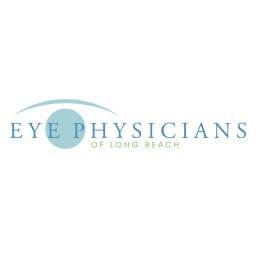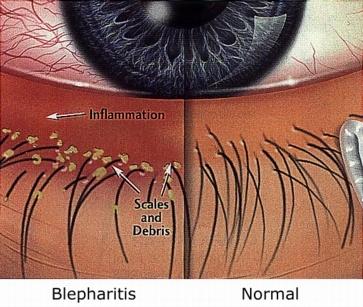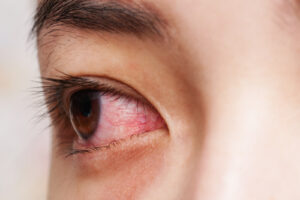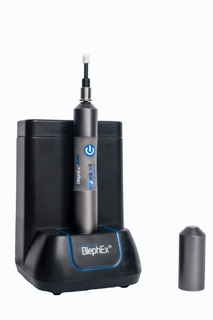Blog post by: Eye Physicians of Long Beach

If your eyes or eyelids are itchy, dry, and irritated, there may be more to it than eye drops or artificial tears can treat. For many people, this could be a sign of dry eye syndrome or blepharitis.
Blepharitis and dry eye syndrome often go hand-in-hand and can be extremely frustrating and uncomfortable to deal with. Keep reading to learn about a treatment option called BlephEx that may help treat your blepharitis and dry eye symptoms!
What is blepharitis?

Blepharitis is an eye condition that results in inflammation of the eyelids. It’s most common in people that have dandruff, oily skin, or rosacea.
When you have blepharitis, you may experience uncomfortable symptoms like burning, soreness, swollen eyelids, or redness. You may also develop flakes or crusts wrapped at the base of your eyelashes.

Blepharitis occurs because of too much bacteria forming at the base of the eyelashes, which causes dandruff-like flakes to form. Some people with blepharitis may also have problems with overactive oil glands in their eyelids, which leads to the symptoms of blepharitis.
There are two kinds of blepharitis: anterior and posterior. Anterior blepharitis develops on the outside front of the eyelashes, which is where your eyelashes grow.
Posterior blepharitis develops on the inner edge of the eyelid which makes contact with your eyeball. Knowing what kind of blepharitis you have makes a difference when it comes to treating it.
Although there is no cure for blepharitis, there are treatment options to help make it more bearable to live with.
How is blepharitis normally treated?
How your eye doctor will choose to treat your blepharitis depends on the severity of your symptoms. Common treatments used to treat blepharitis include:
Eyelid scrubs
Part of the issue with blepharitis is the build-up of flakes and bacteria on the eyelids. Eyelid scrubs help remove any build-up and leave a clean eyelid.
Soak a clean washcloth, a Q-tip, or a lint-free cosmetic pad in baby shampoo that’s been diluted in warm water. Don’t use hot water, as this can cause further irritation.
Then, use it to gently scrub the base of your eyelashes. Do this for about 15 seconds.
You should perform eyelid scrubs every day to keep your eyelashes as clean as possible of any detritus or build-up. Make this a habit you get into before you go to bed if you find you forget things easily.
Antibiotics (ointment or orally)
If you’re producing too much bacteria, your ophthalmologist may start you on an antibiotic ointment. This ointment is for use on your eyes.
Start by washing your hands. Then, put a small amount of the ointment onto a Q-tip or your clean fingertip.
Next, apply the ointment only to the base of the eyelashes. Most patients do this right before bed but do as your doctor recommends. Besides an antibiotic ointment, your ophthalmologist may also prescribe an oral antibiotic as well.
Warm compresses
If your eyelids or eyelashes have a lot of detritus, warm compresses may be something you find helpful. Wet a washcloth with warm water.
Wring it out until it’s almost dry, but not fully dry. Then, place the warm washcloth across your closed eyes.
Leave it there for at least a minute. You can wet the washcloth as often as you need to so it continues to stay warm.
Using a warm compress will help loosen any flakes that may be stuck around your eyelashes. It’s also a good way to keep oil glands from getting clogged.
What is BlephEx?

Another way of treating blepharitis is an in-office eye treatment known as BlephEx. BlephEx is a proven treatment method for patients with blepharitis, though it can also provide relief for those with dry eye syndrome as well.
This in-office treatment removes debris from the eyelids and the bacteria that grow in the debris without causing patients any pain!
How does BlephEx work?
The way that BlephEx works is actually quite simple! You can almost liken it to a medical-grade “electronic toothbrush” but for your eyelids.
Using the patented BlephEx handpiece, a medical-grade micro-sponge carefully spins along the edge of the eyelids, the base of the eyelashes, and the eyelid glands. This is to remove any debris and the bacteria that grow in the debris.
To prevent any bacteria from spreading between your eyelids, a clean micro-sponge is used after each eye. Your eyes are also washed after the procedure is over.
The procedure takes ten minutes or less and you’ll receive numbing eye drops before the procedure starts. Though BlephEx is not painful, you may feel a slight sensation of tickling during the procedure.
After your treatment is over, your ophthalmologist will review instructions with you on how to keep your eyelids clean once you go home.
Will I have to undergo more than one BlephEx treatment?
For most patients that undergo BlephEx treatment, they receive them every 4-6 months. To extend the amount of time between your treatments, it’s important to develop a routine that includes regular eyelid hygiene.
BlephEx is not meant to cure your blepharitis, as there is no cure for the condition. But it can certainly help reduce the irritating symptoms of blepharitis and dry eye syndrome.

BlephEx shouldn’t be a replacement for other treatments like eyelid cleansing, eye lubricants, or heat therapy, but should instead be used in combination with them. These treatment options work best when used together.
Living with blepharitis and dry eye syndrome? BlephEx treatment may be right for you!
Schedule an appointment with one of the expert ophthalmologists at Eye Physicians of Long Beach in Long Beach, CA today!
